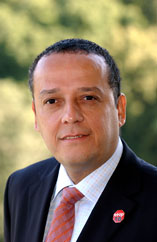Statement by Dr Marcos Espinal

Interview with Dr Marcos Espinal
Welcome to World TB Day 2005
My name is Dr Marcos Espinal, and I am the Executive Secretary of the Stop TB Partnership Secretariat.
During the course of World TB Day, more than 5,000 human beings will die from tuberculosis. This ancient killer, once largely forgotten, continues to claim lives, impede development and defy our best efforts to eliminate it as a threat to public health.
According to the World Health Organization, nearly two million people still die from TB every year. At the same time, roughly one-third of the entire human race -- TWO Billion people -- are today infected with the TB bacillus and at risk from the disease. This is an unacceptable human tragedy.
There are few medical mysteries in TB control. A cure exists, using medicines that cost between $10 and $14 US dollars per patient in most countries. The strategy to control TB that is recommended by the World Health Assembly and the STOP TB Partnership -- called DOTS for short -- has proved successful in every part of the world and is one of the most cost-effective public health interventions of our time.
No one today need die of TB. No child should see the life of a mother or father destroyed by a disease that is completely curable. This is why World TB Day needs to challenge governments, decision makers and community leaders to strengthen action on all fronts.
We need to stop conducting business as usual and get TB control higher on the political and development agenda.
Investment in TB control is cost effective. With strengthened donor commitment, the tide can be turned against the global TB epidemic but we need the resources to do the job.
We must address the obstacles that stand in the way of expanding DOTS, most importantly the health work force crisis, weak laboratory services, inadequate management of multidrug resistant TB, and the dual epidemic of HIV/AIDS in Africa that is severely undermining efforts against TB there.
The faster we address these obstacles, the greater chance we have of meeting the global targets for TB control and the Millennium Development Goal of reducing the global burden of TB by half by 2015.
The focus of this year's World TB Day is frontline TB care providers, who are the cornerstone of all our efforts.
They include grassroots-level public health staff, lab technicians, non-governmental organizations, community groups, clinicians, nurses, private medical practitioners, pharmacists, shopkeepers, academia, students, and patient activists.
We salute these individuals who work so hard day in and day out, for they are the true unsung heroes of this global crusade. They now diagnose, treat, support and ultimately cure more than 3 million TB patients each and every year.
On behalf of the 300 members and partners of the Stop TB Partnership let me express my gratitude for your efforts and encourage you to keep up the good work.
Thank you
